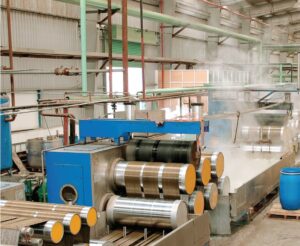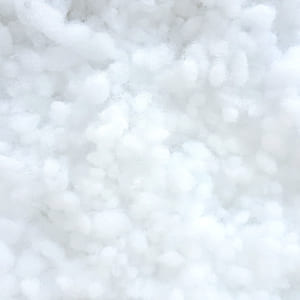What is flax (linen)?
Once one of the world’s most common textiles, linen now represents only 1% of global apparel fibers in use. Consumption peaked in 2005 at 709,000 tons and has been in decline since. It is the oldest known plant fiber used to make textiles and was widely used until displaced by cotton. Primary apparel uses are for suits, shirting and summer wear.
Flax is a cellulosic bast fiber that is found in the stems of the annual plant Linum sitatissimum. Flax plants produce a fiber bundle that contains many closely-packed cells that provide significant strength to the resulting linen. Flax is grown and consumed primarily in China, Russia, Poland, the United States, Italy, and France. France is considered to produce the highest quality flax.
ATTRIBUTES
Flax is primarily cellulose and is non-allergenic. Due to its ability to absorb up to 20 times its weight in moisture without dampness, linen is a “breathable fabric” suitable for humid climates. Flax increases in strength when wet. It also does not deform with wear and gains a softer hand with repeated washings. Though easy to treat, linen wrinkles easily. Flax has irregularities that produce a characteristic non-uniformity, which is considered an attractive feature.
Testing methods for grading linen are not very standardized, and there is large variation in quality due to harvest and retting. Flax line fibers may be as long as 700 millimetres, where shorter tow fibers are defined as being shorter than 200 millimetres. Fibers are sorted by density, fineness, softness, strength, color, uniformity, silkiness, length, and other attributes. Line fiber is used for fine materials, whereas tow fibers are used to produce yarns that are coarser.
Characteristics
- Typically stronger than cotton
- Stronger when wet
- Resistant to stretching and shrinking
- Resistant to bleaching
- Quick-drying
- Wrinkle- and mildew-resistant
- Abrasion-resistant
- Retains heat-set pleats and creases
- Machine washable
MAKING
Material Sourcing
Crops are sown in early to mid-spring in Europe or as a secondary crop in late fall in warmer regions. The crops grow best with 110-150 mm of rainfall, and require moist conditions, moderate temperatures, and sun exposure. Flax is cultivated in soil with neutral pH, and requires extensive rotation of 4-7 years between harvests. Fertile, medium-heavy soils such as humus sandy clay soil are best for production. Cultivation requires maximization of spacing between plants, due to a root structure that utilizes all available nearby water.
The fibers that produce linen are filaments that vary in length by height of the leaf to which it connects. These filaments are grouped by tissue made of pectin which must be removed during processing. Fiber quality and length is determined by plant maturity and vegetative growth. Every leaf on the flax plant has ten connecting filaments grouped together, thus the total filaments are equal to ten times the amount of leaves each plant produces.
Harvesting involves using machines to pull the full plant from the ground instead of cutting, to preserve filament quality. Plants must then be de-seeded and the straw separated from the fiber. The latter starts with a process called retting, which breaks down the pectin that surrounds the fibers and binds them together within the plant straw. All the pectin must be removed properly to produce high quality fiber.
Processing
Harvested flax is usually dew-retted in Northern Europe due to the high cost of required effluent treatment following water retting in tanks; in China, approximately 80% of the flax crop is water retted in tanks or rivers. Dew retting involves leaving the plants exposed to dew, sunlight and rain on the field for roughly two months to facilitate natural bacterial decomposition of the pectin. The process dissolves bark and softens the pectin sufficiently to allow for subsequent separation of the fiber and straw. During the two month period, the flax is turned by machines so that it is evenly retted; deseeding occurs roughly ten days after the initial harvest. Dew retting requires careful attention to ensure even and complete retting and more typically there is significant variation in the results. Water retting is a minor method that is now rarely used as it requires submersion in a water body for up to several weeks to facilitate quicker bacterial action; the method requires large amounts of water – rivers and ponds are typically used – and produces a significant amount of biological oxygen demand on the water body creating sludge and depleting the oxygen supply in the water. Water retting can also be done in tanks.
Problems with dew and water retting have led to new methods of preparing flax for fiber separation. These include osmotic, enzymatic, and electric resonance degumming, which eliminate the need for natural bacterial action thereby reducing variability and pollution. Osmotic degumming methods produce homogenous fibers with high fineness and tenacity and are more consistent than retting. Enzymatic degumming also improves uniformity of the fiber and can be a biodegradable treatment method.
Decortication is a mechanical process that eliminates the need for retting and involves breaking off raw straw producing a low quality fiber. It is used primarily because it is faster and less expensive than other methods.
Retted or degummed fiber is separated from the straw via scutching then followed by a hackling process. Scutching is a mechanical process that breaks the flax tops and bottoms (root end), separates the fibers from the retted straw, and divides them in bundles by length. Hackling is the process of separating the scutched fiber bundles, which are placed on frames followed by combing, which cleans, untangles, and aligns the fibers for sliver formation. Hackling yields about 55-65% long “line” fiber from the scutched fiber bundles, which are the most valuable for apparel. The remainder is tow in the form of shorter tangled fiber, which requires carding prior to spinning.
In sliver formation a spreadboard feeds overlapping line fibers to create the sliver which is coiled and pressed, and then doubled and drafted to create uniform bundles called roves. Roving twists slivers onto bobbins in preparation for spinning. Rove may be boiled or bleached to remove remaining contaminants prior to spinning into yarn.
Spinning
Flax can be spun in many ways, including ring spinning, rotor spinning and friction spinning, depending on purpose. Flax fiber may be wet or dry spun, though the majority of producers in Europe use dry-spinning methods. Wet spinning is special to flax as it produces high quality yarn, traditionally with line fibers, but its use is diminishing. Dry-spinning requires less energy consumption and water use than wet spinning.
Spinning of flax fiber is very slow compared to other fibers and does not have high levels of automation. This Is due to the long and irregular fibers, which have low elongation and high rigidness.
The yarn is then wound and prepared for weaving or knitting. Paraffin wax is added if the yarn will be knitted.
Line fibers may be spun with cotton, wool, silk, viscose, polyester, or a variety of other fibers to produce blended yarns.
Flax may be “cottonized” by reducing the size of the fiber to a staple length similar to cotton, which allows for processing with other fibers, such as cotton, on existing equipment.
Textile Construction
Warp and weft yarns may have different specifications, depending on the purpose of the final textile. Yarns are processed by either direct-beam warping or sectional warping. Color matching is required if using flax from separate batches.
Specialized looms are frequently used for linen production, and the room in which it occurs is carefully climate controlled for temperature and humidity. Blowing and suction devices are also utilized to reduce dust accumulation during weaving. Looms utilized for linen production include high-capacity shuttleless systems such as rapier or projectile looms. Most production occurs on rapier looms, with projectile utilized for production of wide width textiles. These modern looms reduce noise and improve efficiency and fabric quality.
There are challenges to producing unblended knit linen fabrics due to rigidity and irregularity in fibers, as well as low fiber extension. Pure flax has been generally woven, as knitted linen is less stable, although knitted linen blends will help reduce rigidity and improve stability. Improvements in yarn spinning in recent years have led to increasing availability of linen knits.
Sizing and oiling of linen yarns is often used to reduce pilling and friction during production, as well as dust formation. During sizing, starch is used to improve the strength and lower friction during weaving, and must be removed before finishing.
Dyeing and finishing
Linen is dyed with vat or reactive dyes and may be Mercerized or treated with anhydrous liquid ammonia for improved dye penetration. It may be difficult to dye when combined with other fibers, due to different dye class requirements. Dyeing may be carried out by several methods, but must be well prepared and free from creases beforehand to reduce wrinkles. Various finishing processing include calendaring and beetling to improve plasticity of fibers and durability, as well as chemical finishing to enhance appearance and performance.
To put it short, Linen is a bast fibre with interesting characteristics, which scores relatively well in terms of sustainability – especially if sourced from Europe or places that use environmentally safe retting and processing methods.
INS AND OUTS
Process inputs
Cradle to gate energy requirements differ depending on tilling and retting practices. Herbicides applied during dew retting require large amounts of energy, though bio-retting requires the largest energy usage.
Flax grows best in regions with 600-650 mm of annual precipitation, and is highly susceptible to water shortages during vegetation, as well as during retting. Processed flax fiber before spinning has a virtual water footprint of 2,866 L/kg green water (water use), 481 L/kg blue water (water consumption), 436 L/kg grey water L/kg. Flax is often grown in regions with adequate precipitation to meet crop requirements such that irrigation is not typical.
Warm-water retting requires very large amounts of water for immersion, such as lakes, streams or large tanks, and generates large amounts of waste water. This process has been mostly abandoned in countries with environmental regulations, though some still occurs in Eastern Europe.
Flax seed is required for sowing of the crop, and various fertilizers, pesticides, fungicides and insecticides are applied.
Process outputs
During production of linen, short tow fibers are produced that can be used for paper or insulation. Shives are another co-product used in industrial products. Per kg of flax yarn, co-products include 4.5 kg of short fibers, 7.1 kg of shive, 2.8 kg of dust, and 2.3 kg of coarse plant residue. Almost every co-product may be used including dust that is collected and used as biomass fuel.
Water retting, mostly unused in Europe and other developed flax producing countries, produces about 30 m3 of sludge per ton of retted straw.
Flax production is estimated to generate 0.0003 kg hazardous waste per kg flax.
IMPACTS
Material Benchmark
As illustrated in MADE-BYs material benchmark, Linen scores relatively well in terms of sustainability. Organic Linen is in the best class (A), while conventional Linen is in class C.
Remember that the MADE-BY benchmark tool is a cradle-to-gate material scoring tool, which addresses impacts that range from the extraction or production of raw materials, through manufacture and finishing, to when the material that is ready to be assembled into a final product.
Notice that organic Linen is found in Class A and conventional Linen in Class C
Score In MSI
A material score can also be found in the Higg Material Sustainability Index, under ‘Bast Fiber’, however the options for choosing verious ways of sourcing is currently limited.
OTHER CONCERNS
Availability Of Material
Flax fibers are costly, due to a higher demand for fine fibers than global supply. Flax fiber produced with conventional methods is shown to pollute and use large amounts of water, leading to a major decrease in linen production in Europe after the 1980s, driving a large shift in global textiles to substitute fibers. Some of these issues have been solved with newer methods of retting and spinning, as well as processing that allows blending with other fibers.
The European Linen and Hemp Confederation labels their products as Masters of Linen to promote the connection of superior quality with local production.
Availability Of Certified Material
Certified organic flax is available. In addition, yarn and textiles may be certified to the Global Organic Textile Standard (GOTS) for processing and for organic fiber content to the Textile Exchange Organic Content Standard (OCS), and include spinners Iafil, Linificio E Canapificio, as well as weaving mills such as Libeco.
MATERIAL SNAPSHOTS
This post series #Material Snapshotsshares a curated mix of Textile Exchange’s Material Snapshots and Materials Summaries, for free. To access all available information, visit Textile Exchange, where full pdfs detailing every material can be bought.
Textile Exchange’s Material Snapshots and Materials Summaries are a set of tools designed to help the reader understand why the choice to use certain materials makes a difference in the textile, apparel, and footwear industry. That choice could result in positive or negative impacts depending on the material and supply network details. These snapshots and summaries can help brands make decisions on which preferred fiber or material is the right choice for them by providing a concise look at the raw material options, including agricultural processes, social impacts, and processing differences that make material sustainability profiles different. They also provide information on material properties, certifications, and sourcing information since sustainability is only one of the many reasons why a particular material is chosen.
The two sets of resources – the Material Summaries and the Material Snapshots – are designed to be used alongside each other within an organization to help educate and enable informed, intelligent fibre and material choices. The Material Summaries are geared more towards the designer/developer user in the company, whereas the Material Snapshots are designed for more technical users such as materials, sourcing and sustainability professionals.
Source from Design For Longevity





